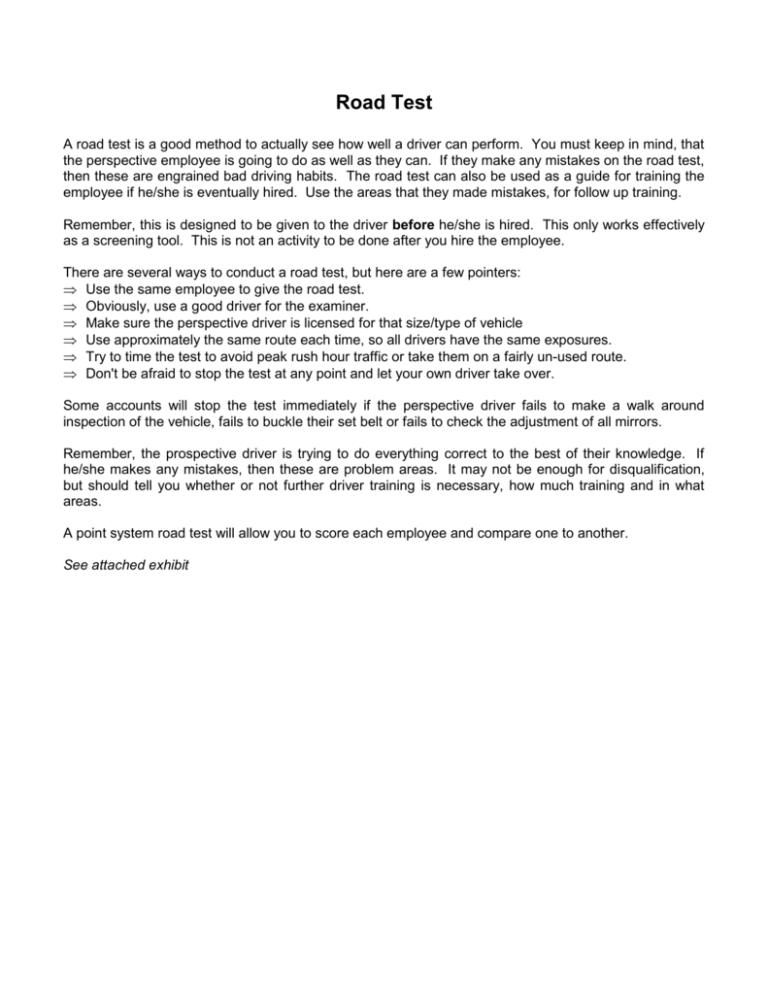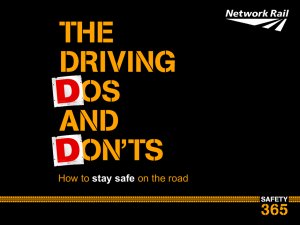Road Test - Tool Box Topics
advertisement

Road Test A road test is a good method to actually see how well a driver can perform. You must keep in mind, that the perspective employee is going to do as well as they can. If they make any mistakes on the road test, then these are engrained bad driving habits. The road test can also be used as a guide for training the employee if he/she is eventually hired. Use the areas that they made mistakes, for follow up training. Remember, this is designed to be given to the driver before he/she is hired. This only works effectively as a screening tool. This is not an activity to be done after you hire the employee. There are several ways to conduct a road test, but here are a few pointers: Use the same employee to give the road test. Obviously, use a good driver for the examiner. Make sure the perspective driver is licensed for that size/type of vehicle Use approximately the same route each time, so all drivers have the same exposures. Try to time the test to avoid peak rush hour traffic or take them on a fairly un-used route. Don't be afraid to stop the test at any point and let your own driver take over. Some accounts will stop the test immediately if the perspective driver fails to make a walk around inspection of the vehicle, fails to buckle their set belt or fails to check the adjustment of all mirrors. Remember, the prospective driver is trying to do everything correct to the best of their knowledge. If he/she makes any mistakes, then these are problem areas. It may not be enough for disqualification, but should tell you whether or not further driver training is necessary, how much training and in what areas. A point system road test will allow you to score each employee and compare one to another. See attached exhibit Suggested Road Testing Tips As a part of your companies driver screening process, a road test can help to determine the driving habits of the candidate. The following information will prove helpful in conducting such a test. A. Setting Up The Course Road testing is one means of determining how a driver applicant will perform if employed by your firm. A standardized road test will involve more than around the block. Consider a route that includes exposure to routine road hazards which the prospective employee will likely encounter on a day-to-day basis as a driver for your company. Therefore, you must first plan the course on a map to include streets, alleys, expressways, back roads, bridges, grades, overpasses, school zones, railroad crossings, controlled intersections, left turns, right turns, backing and parking situations. An ideal test run will cover 10-20 miles. B. Establishing Performance Standards Measure the effectiveness of the road test by having several of your best drivers run the course. Consider using their average score to serve as a standard for qualification. C. Administering The Road Test Check the applicant's drivers license to determine if he/she is licensed to drive the class of vehicle to be operated. Provide him/her with a map of the course and give him/her instructions. Let them get the feel of the vehicle and become familiar with the controls by proceeding with a yard test which could include a pre-trip inspection, hooking-up, backing and parking procedure before pulling onto the road. Give directions for the route well in advance to avoid last minute maneuvers, but do not distract them with unnecessary conversation enroute. D. Evaluating the driver The road test has three categories: QUALIFIED - meets company performance requirements NEEDS IMPROVEMENT - marginal performance but can be improved with training UNQUALIFIED - does not meet company standards Since most drivers will not have a perfect score, you may consider using the road test results as a basis for future remedial training to upgrade their performance. The test will assist in determining initial driving skills and habits, however there are many driver traits that can only be discussed through use of a probationary period with a supervisory driver. Where possible it is suggested such a probationary period be instituted as part of your final selections process. Sample Road Test The following maneuvers are typical of the driving skills you will want to observe. Individual items should be added or deleted according to your own fleet needs. Name: __________________________________________________ Date: _______________ Truck # _______ Car # ________ Make ________ Type ___________ Cap. Check Yes No 1. Uses mirrors correctly and signals before pulling into traffic ............................................... ___ ___ 2. Drives in right lane except when passing ............................................................................ ___ ___ 3. Maintains safe stopping distances in front of the vehicle .................................................... ___ ___ 4. Signals stops, turns and passing movements well in advance of turn ................................ ___ ___ 5. Pulls gradually into proper lane well in advance of turn ...................................................... ___ ___ 6. Approaches green traffic lights, signals, prepared to stop for signal change ...................... ___ ___ 7. Strictly obeys all traffic signs, signals, and road markings .................................................. ___ ___ 8. Yields right-of-way whenever there is any question and otherwise drives courteously ....... ___ ___ 9. R.R.: Slows down, looks both ways (stops if appropriate)..................................................... __ ___ 10. Varies speed to meet conditions, i.e. when approaching schools, curves & intersections .. ___ ___ 11. Makes right hand turn correctly .......................................................................................... ___ ___ 12. Stays in right lane on hills and curves ................................................................................ ___ ___ 13. Uses good judgment in deciding when to pass................................................................... ___ ___ 14. Keeps car in gear downhill, shifting to lower gear if necessary (trucks) .............................. ___ ___ 15. Picks safe place to turn around with clear view both ways, turns skillfully .......................... ___ ___ 16. Avoids backing when possible, backs only when knows everything is clear ....................... ___ ___ 17. Stops off traveled portion of highway.................................................................................. ___ ___ 18. Turns wheels to curb and sets hand brake when parking ................................................... ___ ___ 19. Follows vehicle in front at safe distance ............................................................................. ___ ___ 20. Rides the clutch or uses clutch roughly .............................................................................. ___ ___ 21. Stays in low gears/high gears too long ............................................................................... ___ ___ 22. Fails to obtain proper speed when shifting to higher gears ................................................. ___ ___ 23. Uses brakes roughly........................................................................................................... ___ ___ 24. Uses brakes on curves ....................................................................................................... ___ ___ 25. Slips clutch to hold vehicle form rolling back while waiting at traffic signal ......................... ___ ___ 26. Selects wrong gear - upgrade, downgrade or on level ....................................................... ___ ___
